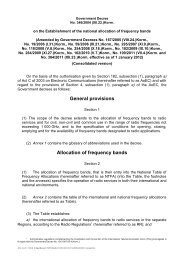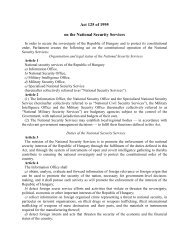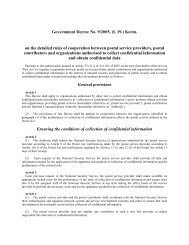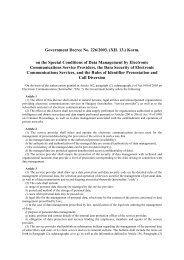The Hungarian Communications Market Developments and ...
The Hungarian Communications Market Developments and ...
The Hungarian Communications Market Developments and ...
You also want an ePaper? Increase the reach of your titles
YUMPU automatically turns print PDFs into web optimized ePapers that Google loves.
08 09<br />
Figure 1.1: NHH’s regulatory objectives<br />
Consumer’s interests<br />
Price, value, choice<br />
Penetration/usage<br />
In Hungary the only guarantee<br />
of the realisation of consumer<br />
interests is competition<br />
Efficient competition<br />
Competition is only<br />
sustainable <strong>and</strong> efficient with<br />
a developing <strong>and</strong> stable sector<br />
Sector interests<br />
Innovation<br />
Investment<br />
Financial<br />
stability<br />
Certain social objectives<br />
(e.g. universal services) relating<br />
to electronic communications<br />
are ensured essentially not<br />
by competition<br />
<strong>The</strong> Authority has developed the target system underlying the<br />
Regulatory Strategy in harmony with its existing mission 10 <strong>and</strong> vision.<br />
<strong>The</strong> framework of such target system is provided by relevant<br />
EU regulations <strong>and</strong> directives, international commitments <strong>and</strong> the<br />
<strong>Hungarian</strong> legal environment, in particular Eht. <strong>and</strong> other relevant<br />
acts <strong>and</strong> decrees.<br />
<strong>The</strong> foremost direct objective is to establish effective competition,<br />
that is a highly intensive competition between market players<br />
in terms of both (access) infrastructure <strong>and</strong> retail services. In the<br />
case of effective competition no market player, either alone or with<br />
others, is able to significantly influence the dynamics of the market.<br />
<strong>The</strong> protection of consumer interests is a further element of the<br />
target system, embodied by affordable prices, high-value content of<br />
products/services <strong>and</strong> a wide range of services on the market. <strong>The</strong><br />
third element of the target system is the cross-sector interest characterized<br />
by three factors: innovation, investment <strong>and</strong> the degree of<br />
financial stability.<br />
<strong>The</strong> regulator’s ultimate goal is to protect consumer interests, yet its<br />
primary indirect objective remains to be the development of effective<br />
competition. If it comes to controversies between the realization of<br />
individual objectives, it is competition that receives priority over the<br />
rest of the objectives. <strong>The</strong> Authority, nevertheless, will consider <strong>and</strong><br />
compare the advantages <strong>and</strong> disadvantages of realizing one objective<br />
over another one, along the principle of net usefulness. In the case of<br />
sector-level interests, the Authority will also consider minimum levels<br />
facilitating the sustainability of competition concerning the indices of<br />
financial stability.<br />
Regulatory principles<br />
<strong>The</strong> principles concerning the application of regulatory instruments<br />
have been formulated in accordance with the regulatory objectives<br />
<strong>and</strong> various market development trends <strong>and</strong> scenarios. Besides the<br />
objectives, it is the principles that guarantee permanence of the Strategy,<br />
as the principles are not linked with specific directions of market<br />
development, which thus have the potential to support the Authority’s<br />
decisions irrespective of market development specificities.<br />
<strong>The</strong> guiding principles mark out the most important principles of<br />
intervention to be followed by the Authority along the three regulatory<br />
objectives (effective competition, consumer interests, sectoral<br />
interests).<br />
Certain inputs in the electronic communications market indispensable<br />
for the provision of services are only available to a limited<br />
extent. Such bottlenecks distort <strong>and</strong> create barriers to the development<br />
of competition, their presence thus makes ex ante market<br />
regulation necessary. <strong>The</strong> Authority’s task here is twofold. First, the<br />
Authority’s long-term goal is to eliminate bottlenecks. Second, as<br />
long as these bottlenecks exist, the Authority must keep the “owners”<br />
of such bottlenecks from abusing their dominance resulting<br />
from them. In the short run, major bottlenecks are constituted by the<br />
level of access infrastructure, primarily due to extremely high entry<br />
barriers.<br />
In the long run, the goal of the regulator’s activity is to contribute<br />
to the development of sustainable, effective <strong>and</strong> “self-supporting”<br />
competition in the telecommunications sector. <strong>The</strong> establishment of<br />
“self-supporting” competition assumes that the bottlenecks of competition<br />
cease to exist or gradually lose their significance. Should this<br />
be the case, the use of sector-specific regulatory instruments may<br />
be replaced by the promotion of self-regulation of the market <strong>and</strong><br />
the use of ex post instruments. In some cases, however, a certain









